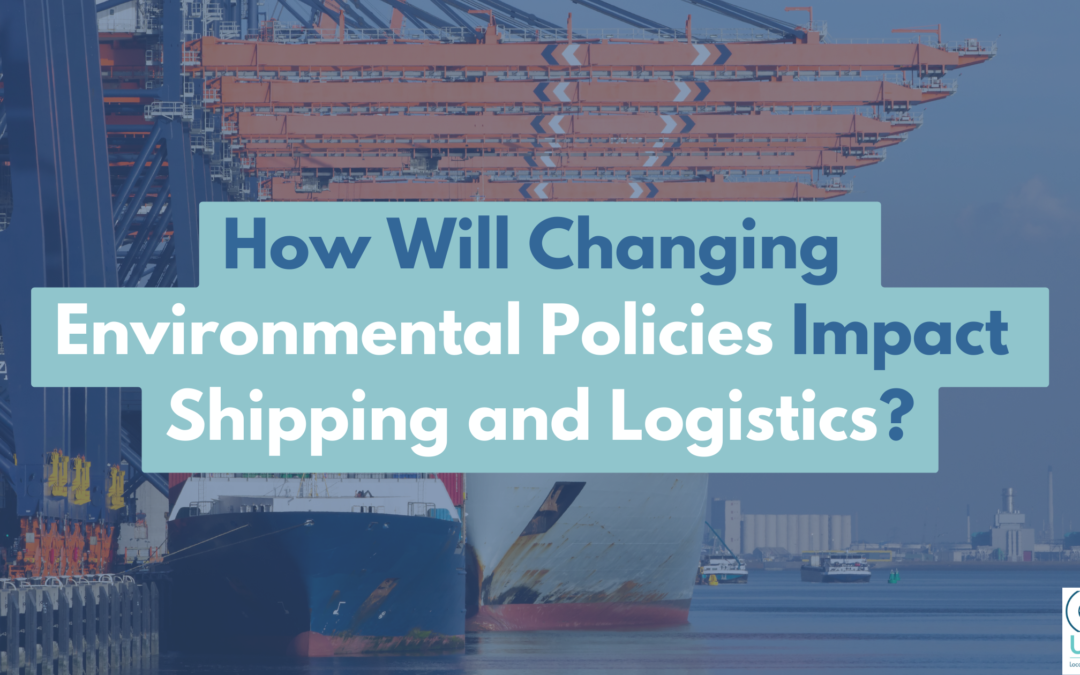
How Will Changing Environmental Policies Impact Shipping and Logistics?
The reality? The logistics industry is notorious for stirring up less-than-positive environmental press. And considering a single Capesize Bulk Carrier uses 40-plus metric tons per day—and releases about 33,000 tons of CO2 in a single year—that shouldn’t come as a surprise.
The global shipping industry generates about 4%-5% of the total carbon dioxide emissions created by human activity. It’s also a massive contributor to sulfur oxide (SOx) and nitrogen oxide (NOx) emissions. Then there’s airborne pollution, especially around coastal areas and highly-trafficked ports.
While it seems black-and-white, moving to green logistics is more complex. Because while shipping and logistics are being pushed to “clean up,” it’s simultaneously hurtling towards another breakpoint as consumer demands skyrocket—especially when it comes to the retail supply chain. Pandemic time demands pushed the global supply chain to its limit and introduced consumers to the simplicity and efficiency of on-demand eCommerce. And there’s no going back.
That’s the critical balance: accelerating shipping and deliveries to satisfy consumer demand while considering the increasing environmental pressures of this growing industry.
Now, though, there’s a third consideration gaining momentum worldwide: cast-in-stone environmental policies set to transform shipping and logistics. From regulatory mandates to emerging tech best practices, the industry’s future and how cargo moves are under the microscope.
Your role, then? Understand the modern landscape with an eye on the complexities, controlling factors, and evolving environmental policies driving what comes next—specifically, the government, consumer, and industry-specific forces looking to define the way shipping happens.
1. Government Sustainability Targets
Underscoring much of the conversation are government regulations and emerging sustainability initiatives. Chief among them is the 2015 Paris Climate Agreement. Legally binding—and agreed to by 196 countries—this international treaty strives to keep this century’s global temperature rise to 1.5℃-2℃.
Since freight transportation is responsible for about 11% of all global greenhouse gas emissions and 20% of black carbon, all eyes are on international shipping.
Considering carbon budgets, getting to a zero-emission state—which syncs with the Paris Climate Agreement’s global warming goals—is possible. But it requires an immediate shift to scaling new technologies, efficiencies, and alternative fuels. And that means allocating the resources, budget, and people power right now. Possible? Potentially—for some organizations. Others may need more time, support, and hands-on guidance to promote these transformation shifts.
Regulatory pressure is also coming from the inside. The International Maritime Organization (IMO) has been laser-focused on mitigating shipping emissions and reducing sulfur content in fuel oil. Per IMO requirements introduced in 2020, ships’ fuel must contain no more than 0.5% sulfur. Their experts argue that this will provide ongoing environmental impacts and public health benefits, including reductions in childhood asthma and lung cancer deaths.
2. Consumer Pressure for Reduced Carbon Footprints – and Greater Performance
Like government pressures, consumers are another key driving force behind changing environmental demands. Eighty-five percent of global consumers admit to evolving their purchasing behaviors, favoring more sustainable companies. They seek out businesses with clear-cut environmental, social, and governance (ESG) strategies and public roadmaps tracking their green goals—even from shipping and logistics providers.
- 91% of e-commerce customers want eco-friendly shipping options at checkout
- More than half would pay an additional 10% for these green services
- 73% who indicated green behaviors aren’t important to them would still like to see sustainable shipping options
3. Industry Insiders and Employees
The push towards more sustainable practices is coming from the inside—and in today’s competitive, candidate-first environment, this commitment can be a competitive advantage. Sixty-eight percent say they’re more likely to accept a job at an environmentally-friendly organization.
Respond To Mounting Internal and External Pressures
While these regulations and demands from consumers and employees inspire countless global conversations, there’s no one switch to flip. Transforming shipping workflows and best practices to improve sustainability must also consider methods for maintaining or improving service—and infrastructure durability.
We can’t compromise construction, deliverability, and design speed for short-term emission reductions. In the U.S. alone, shipments are expected to increase by nearly 24% by 2025 and 45% by 2040.
However, some organizations, ports, and governments are diving in head first, committing to significant investments in initiatives like “ports of the future” in France. Here, maritime, waterway, aeronautic, and land-based transportation come together to preserve space and environmental impact.
These ports are in-step with the French government’s own Stratégie national bas Carbone (National Low-Carbon Strategy), which seeks to curb industrial sector emissions by 35% over the next eight years, and 81% by 2050. Doing this means complete decarbonization in maritime transport—and, already, it’s posing a significant technological challenge, especially with maritime transport expected to increase by up to 40% during the same period. Total adherence to these environmental standards could leave the industry and key French players vulnerable.
Others are choosing to get ahead of any potential roadblocks. With the introduction of the La Rochelle Zero Carbon Territory project—a push for the greater La Rochelle area to be carbon neutral by 2040—the local port has already begun implementing initiatives to curb its energy-related emissions.
Next Steps: What Should You Do Today – and Tomorrow?
By understanding the environmental pressures impacting shipping and logistics, your organization can better prepare for what comes next and how you can and should respond. Economic, political, and financial considerations will undoubtedly contribute to individual businesses’ moves to green logistics. But regardless of where a company falls, the next 12-24 months will mark a seismic shift in the industry as a whole—and that means all organizations and stakeholders must commit to rethinking processes, workflows, and operating models, with sustainability considerations in mind.
No matter your exact path forward, there are negatives and positives—and more than just environmental and public health considerations to account for. Done right, though, companies can strike a balance, making positive strides to better the global community—and their bottom lines.
Need help mapping out your next steps? OL USA can help. With both a big-picture global understanding of the current and emerging policies, regulations, and initiatives driving the future of shipping and logistics—and teams on the ground in key local markets—we can help navigate today and tomorrow. Let’s talk.


